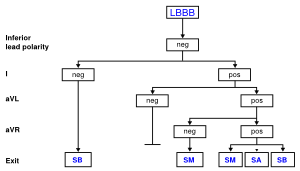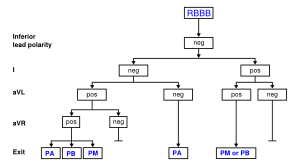Localisation of the origin of a ventricular tachycardia
Jump to navigation
Jump to search

Areas of the left ventricle where VT's can originate from: The left ventricle is depicted as having been opened. Regionsare as follows: IAS: inferoapical septum; AAS: anteroapical septum; AA anteroapical free wall; AB: antero-basal free wall; ABS, anterobasal and midseptum; IBS, inferobasal septum; IM: infero-medial freewall; IL: infero lateral free wall; MI: midinferiorwall; IA: infero apical free wall.Adopted from Miller et al.[1]
The localisation of the origin (or exit site) of a ventricular tachycardia can be helpful in understanding the cause of the VT and is very helpful when planning an ablation procedure to treat a ventricular tachycardia.
Using this approach and the algorithm on the right (to be added soon) [2] the exit site can be estimated with reasonable accuracy (PPV around 70%).



